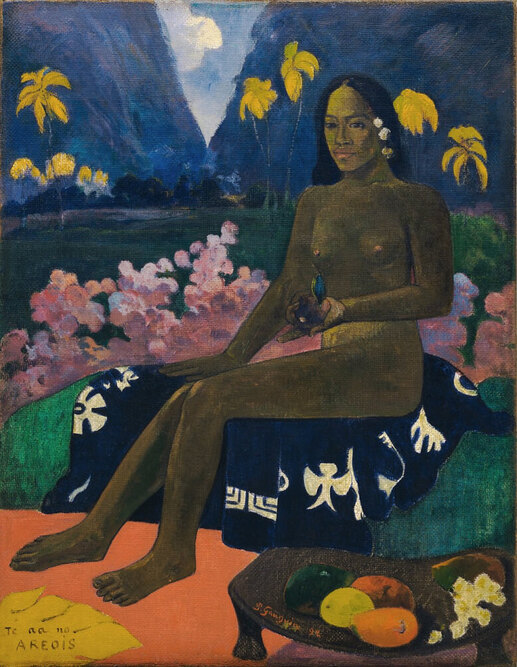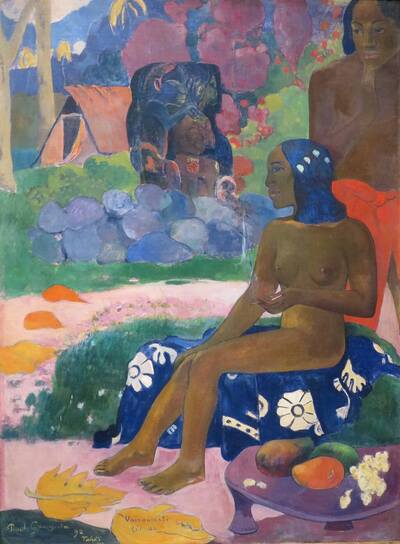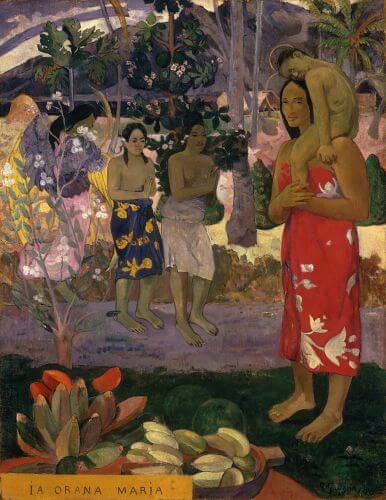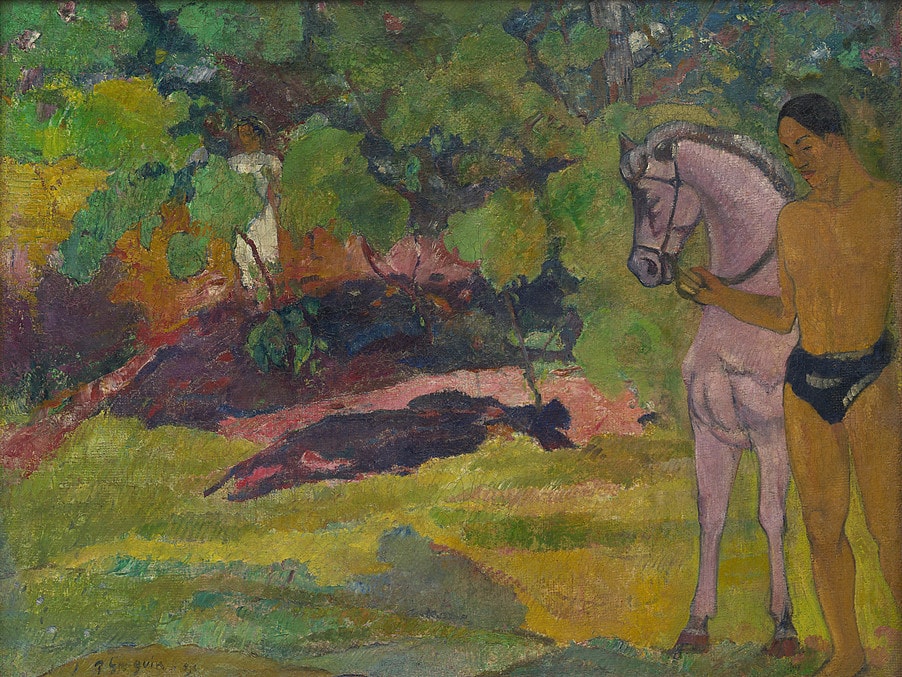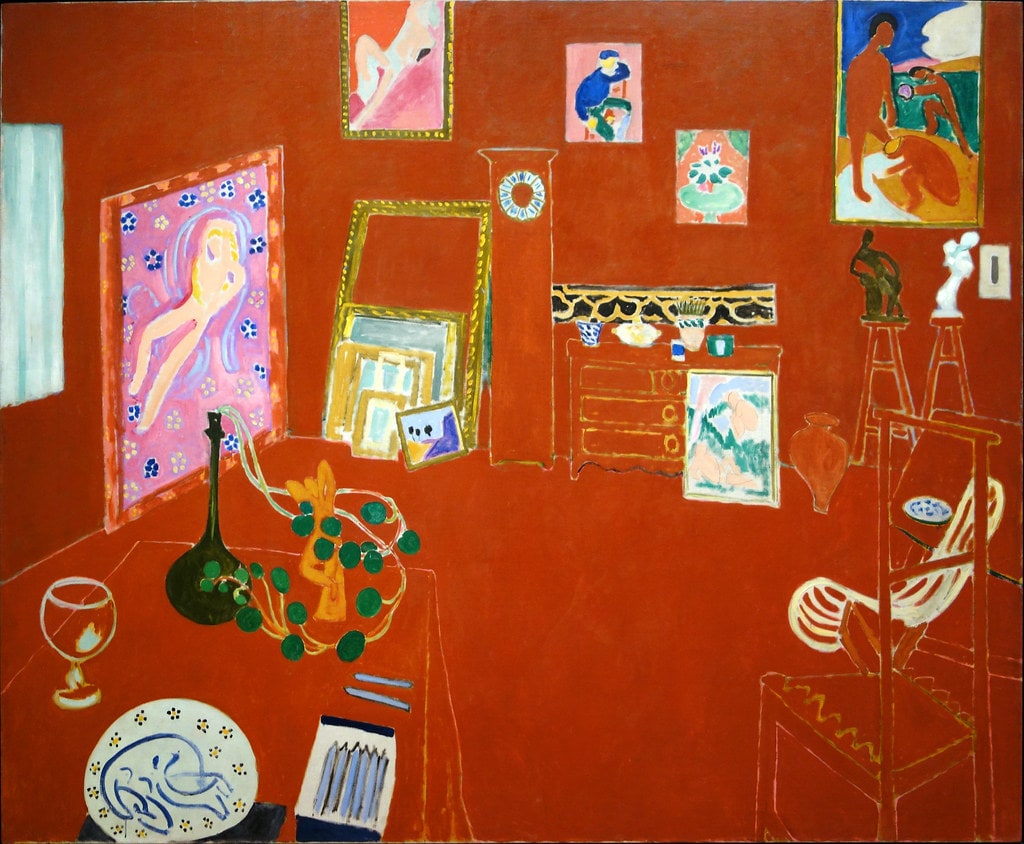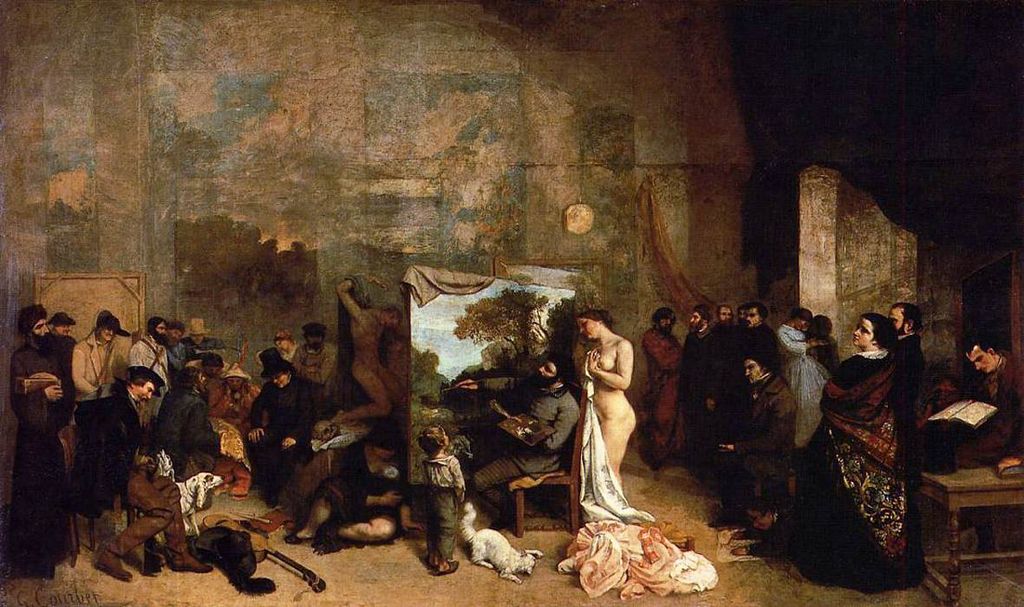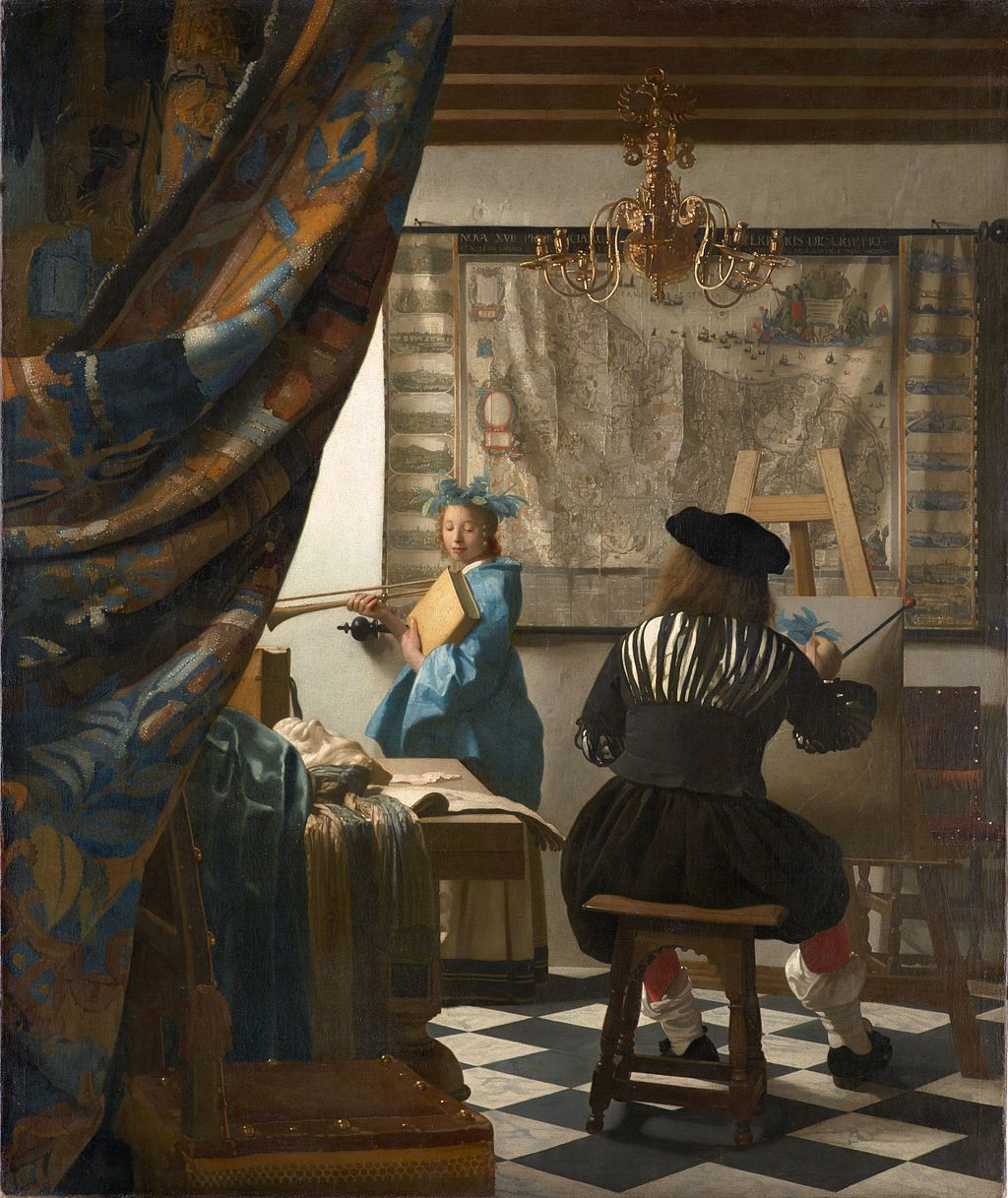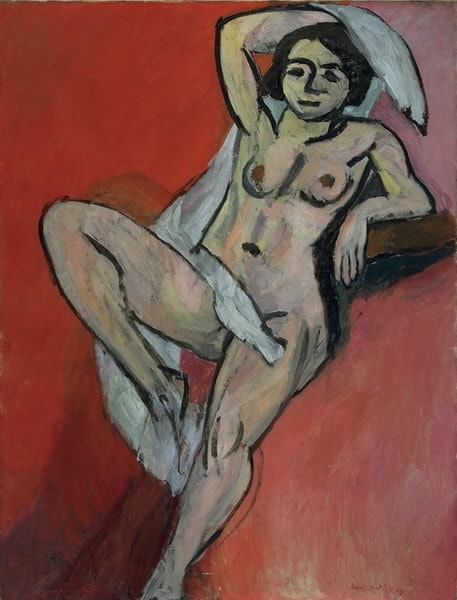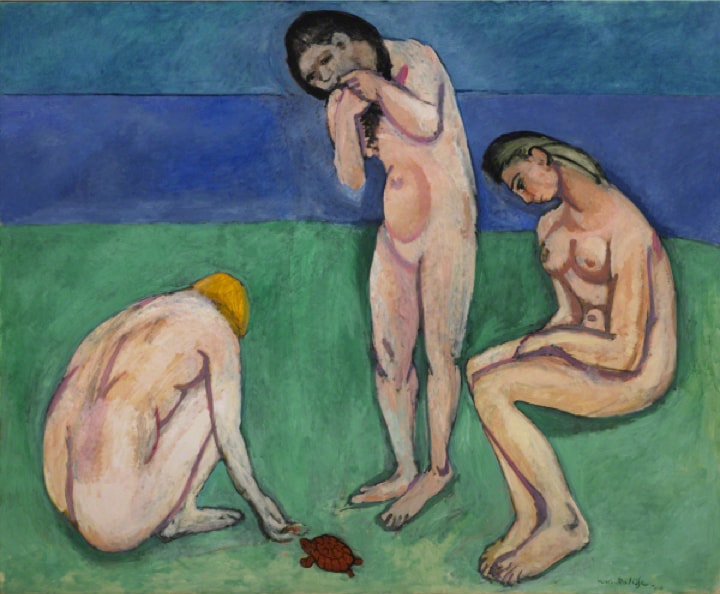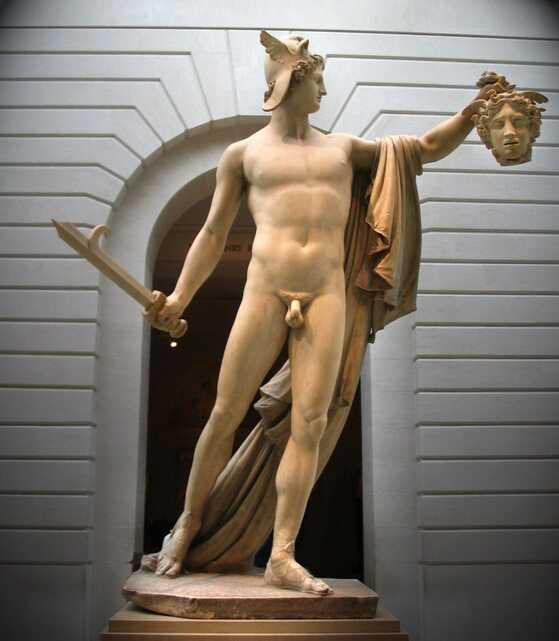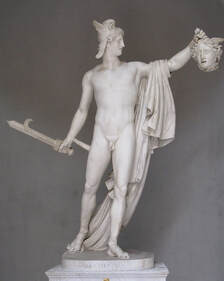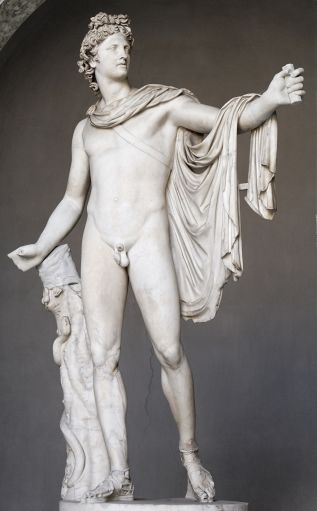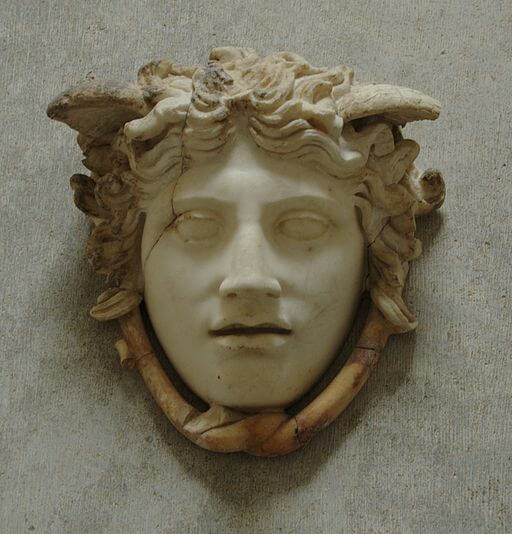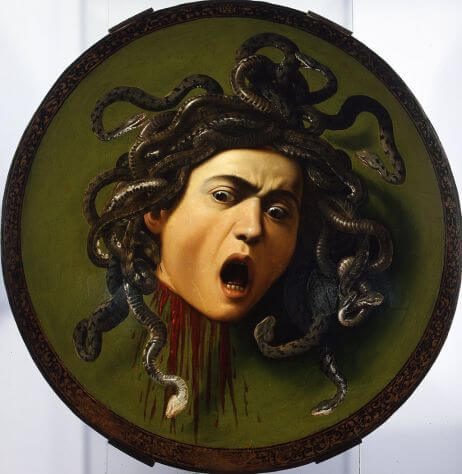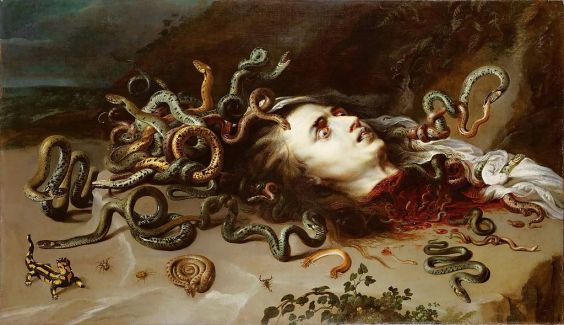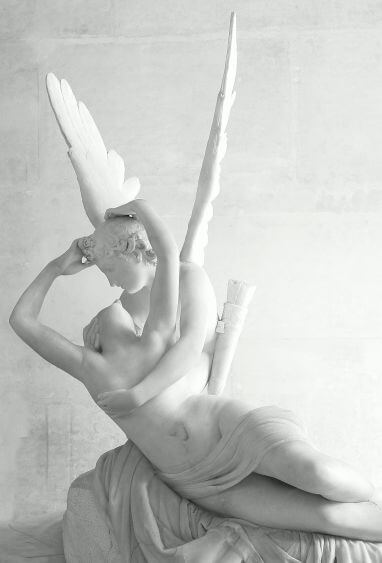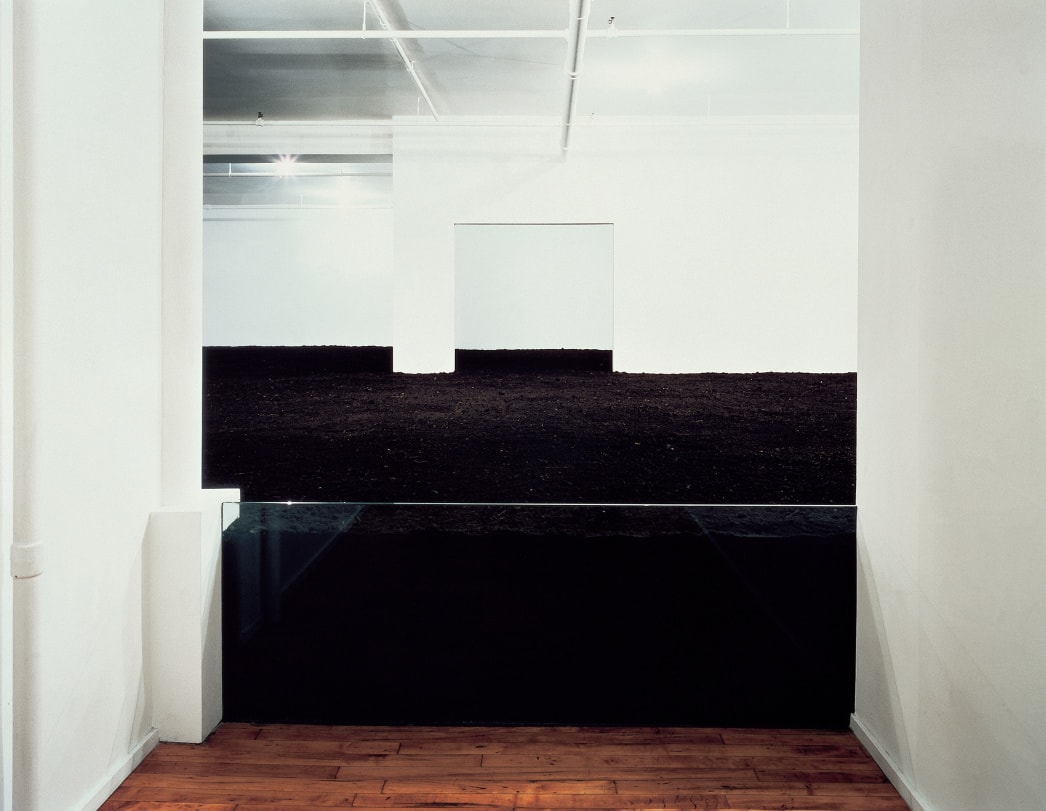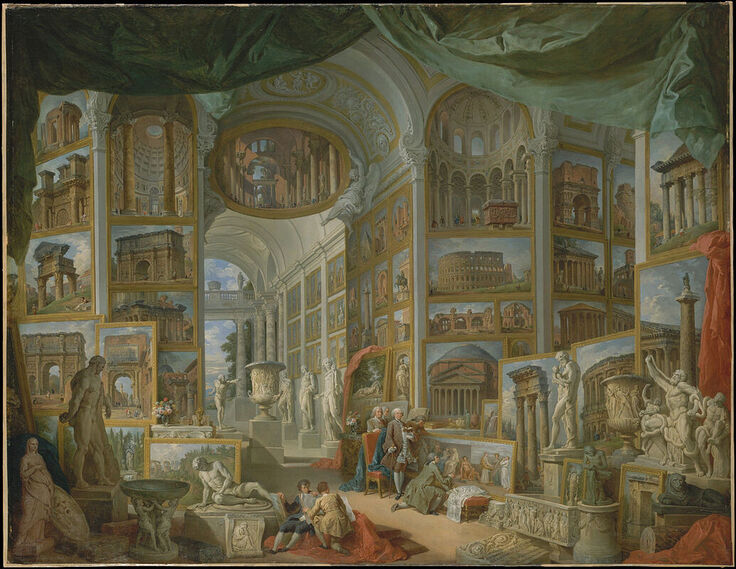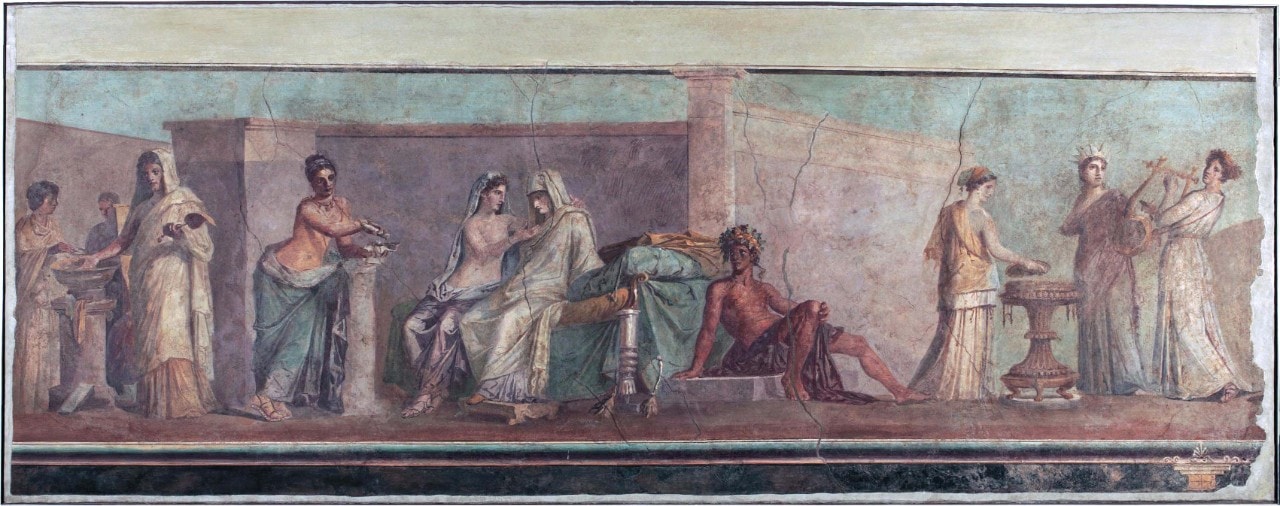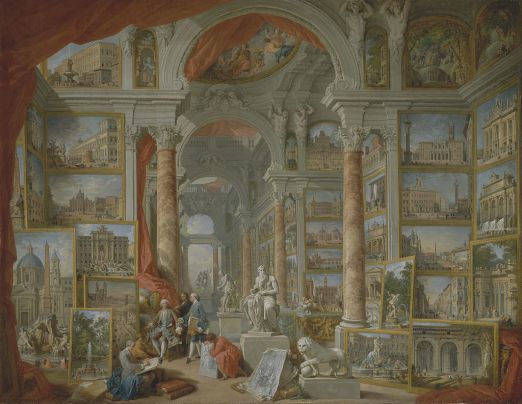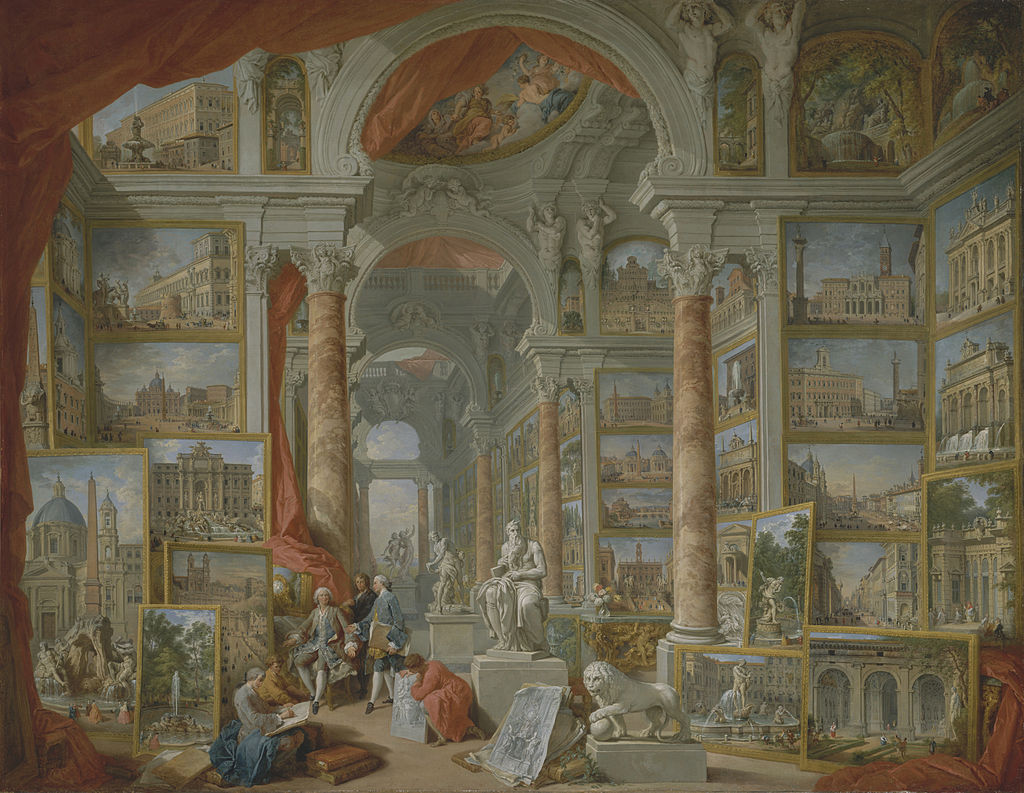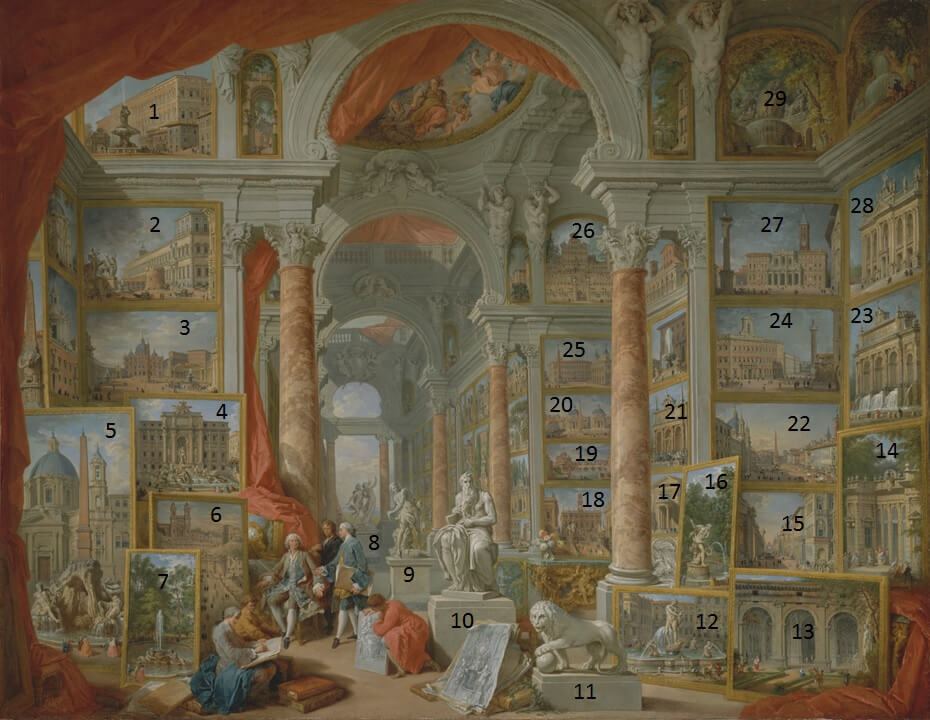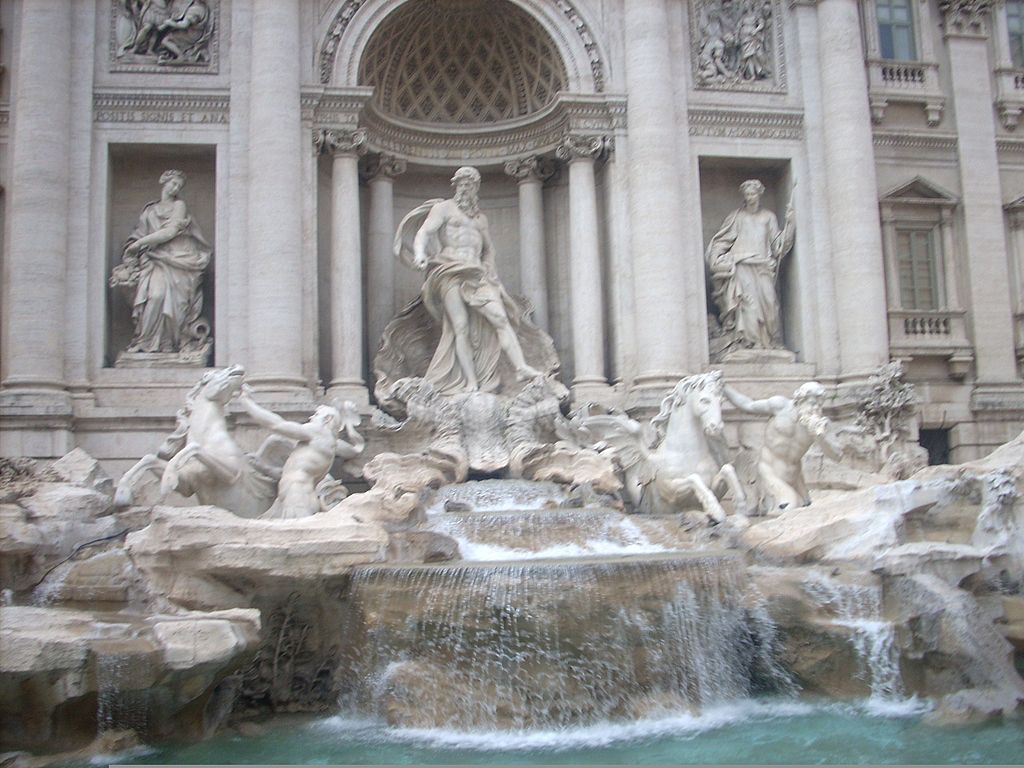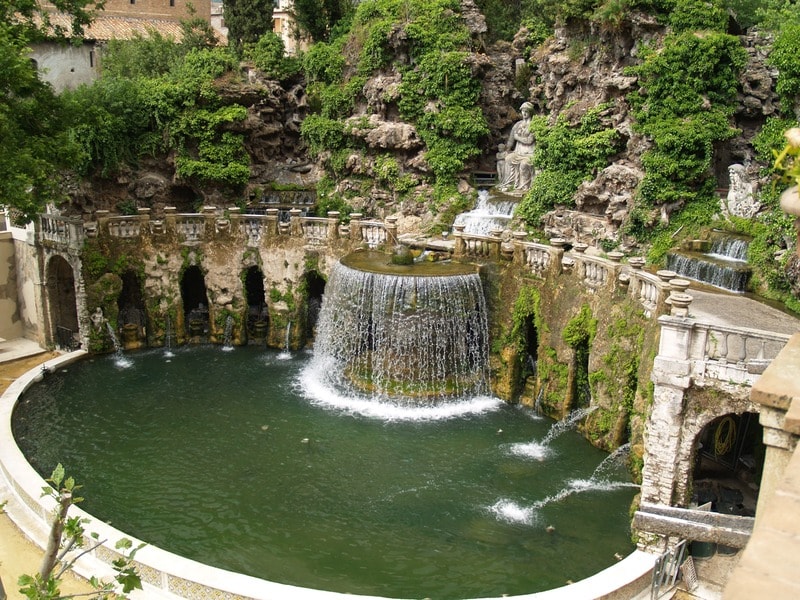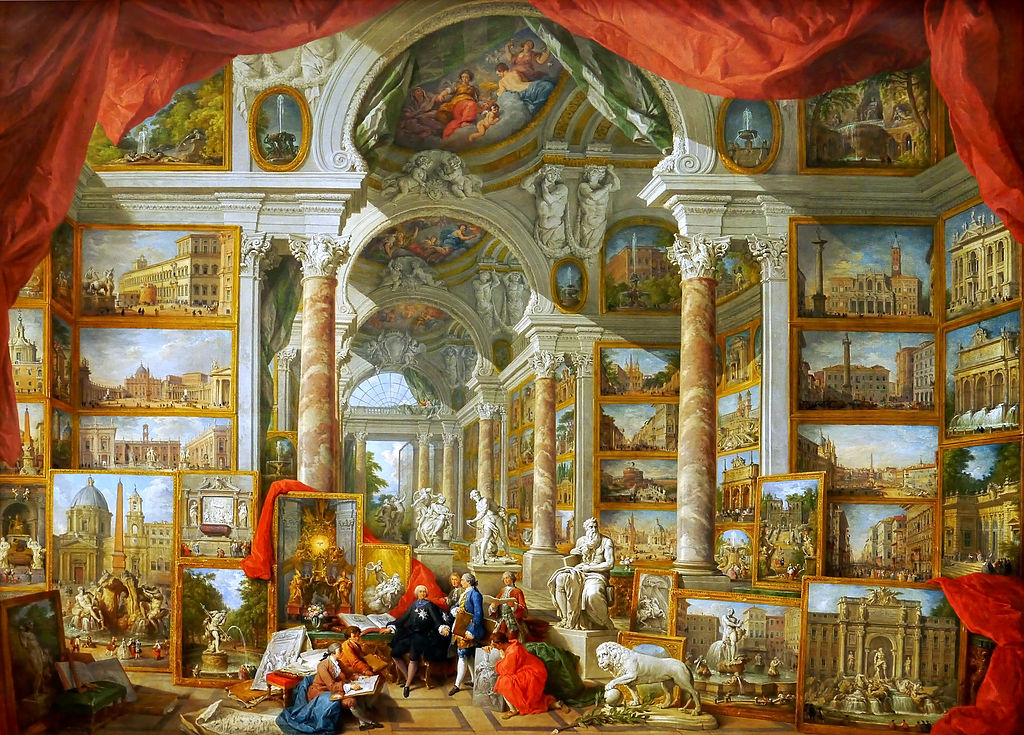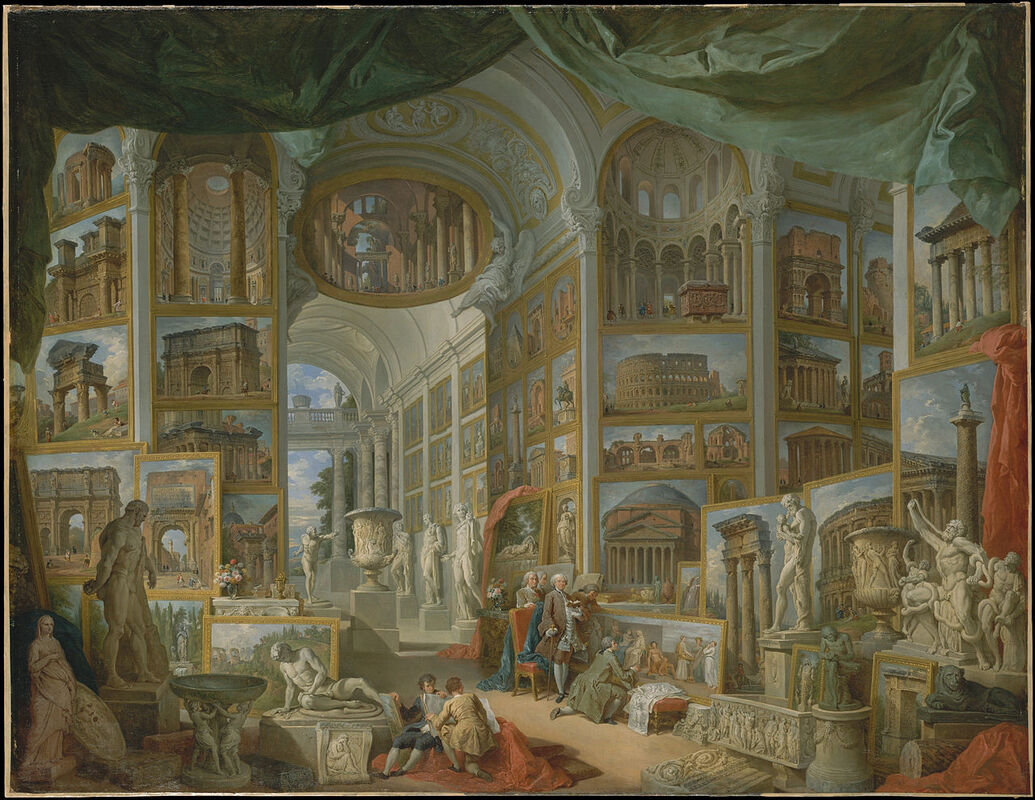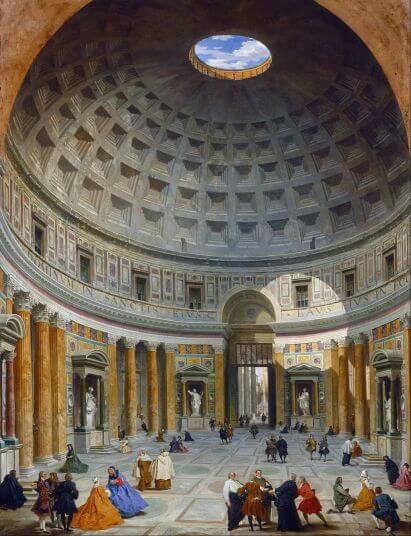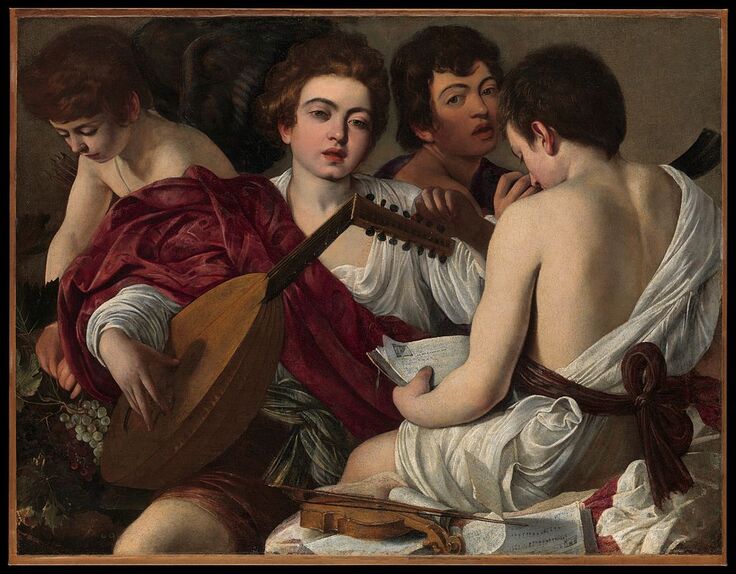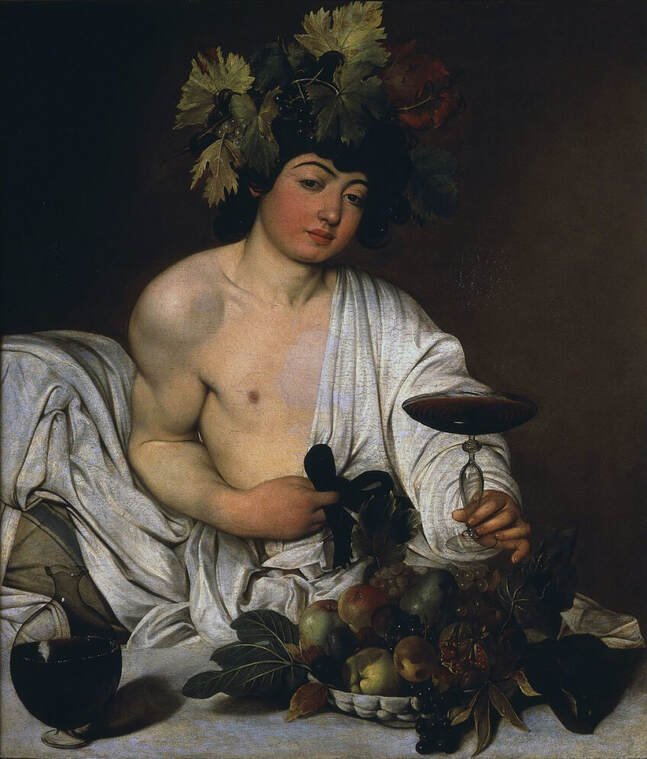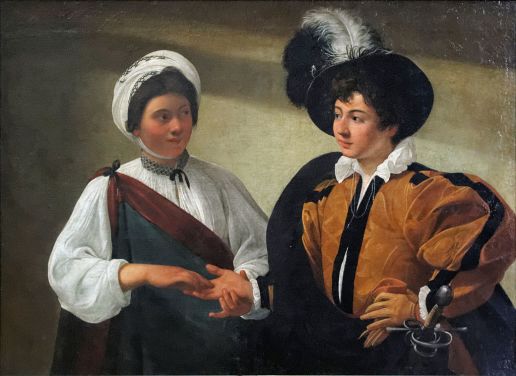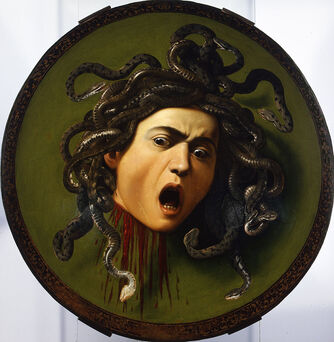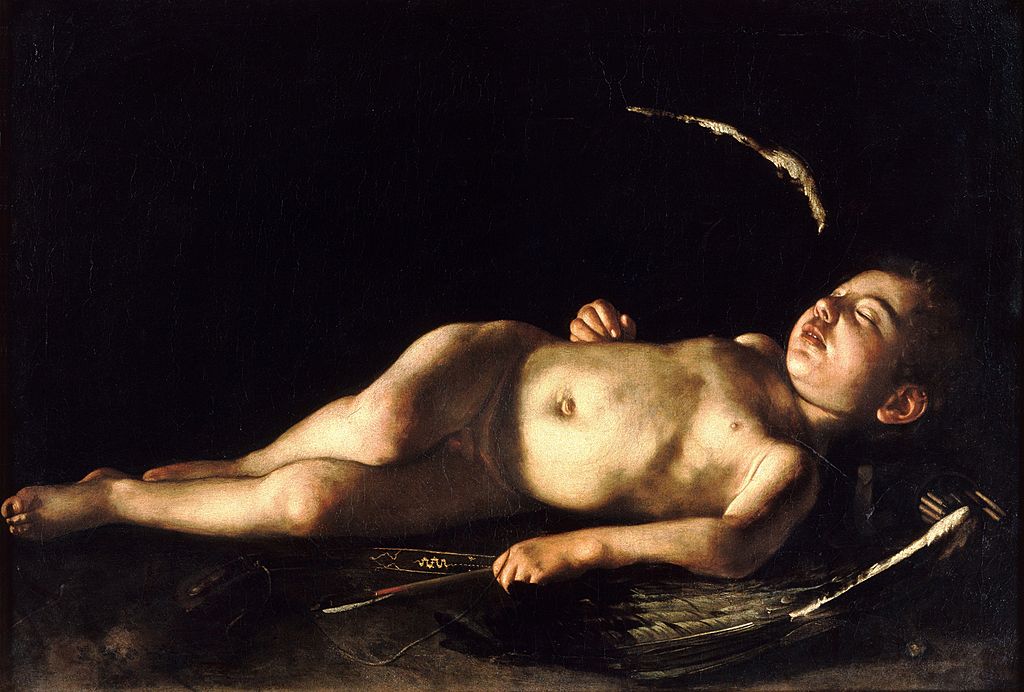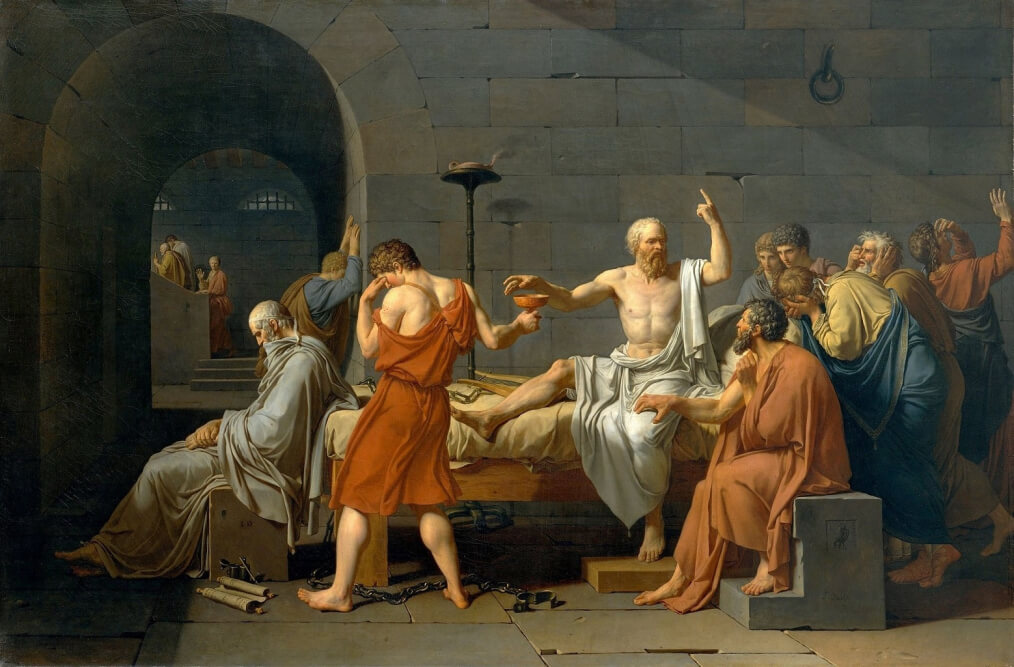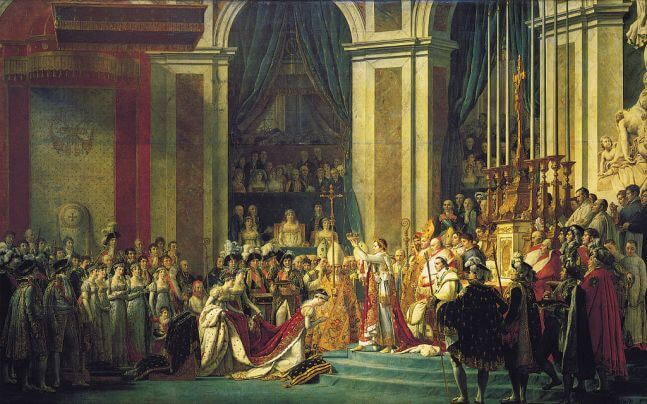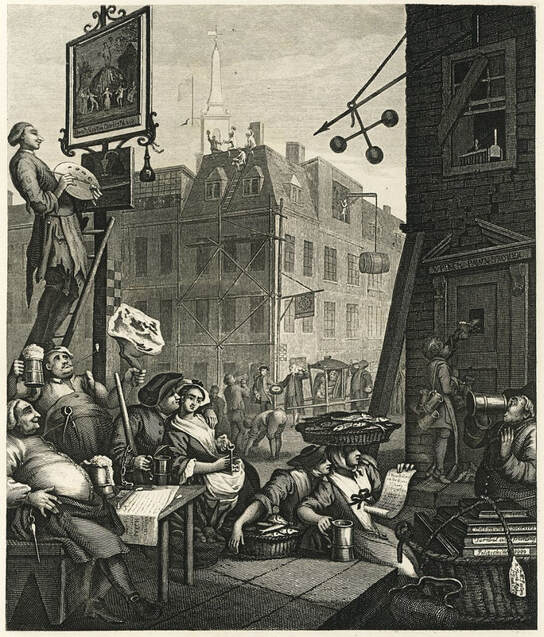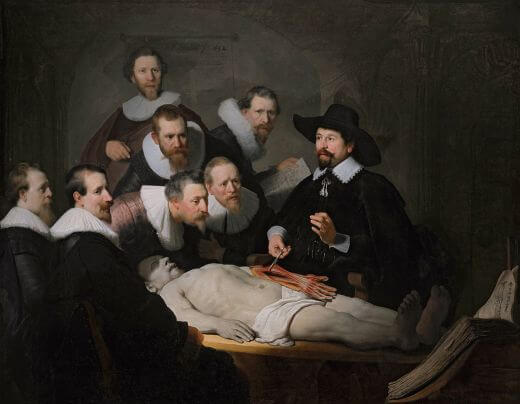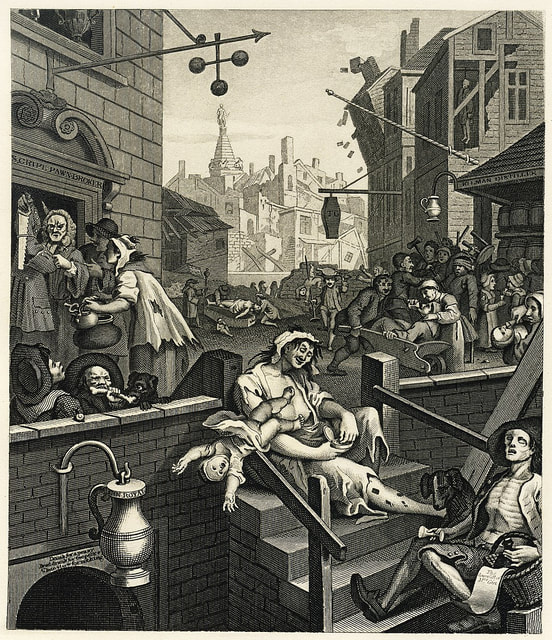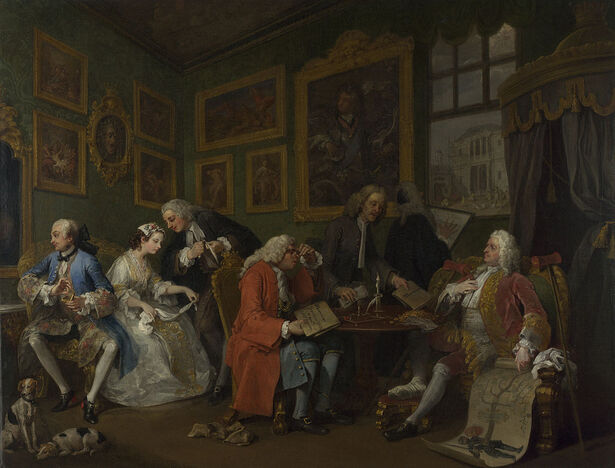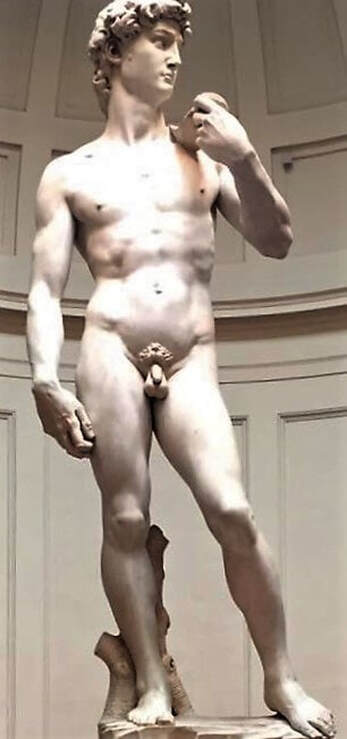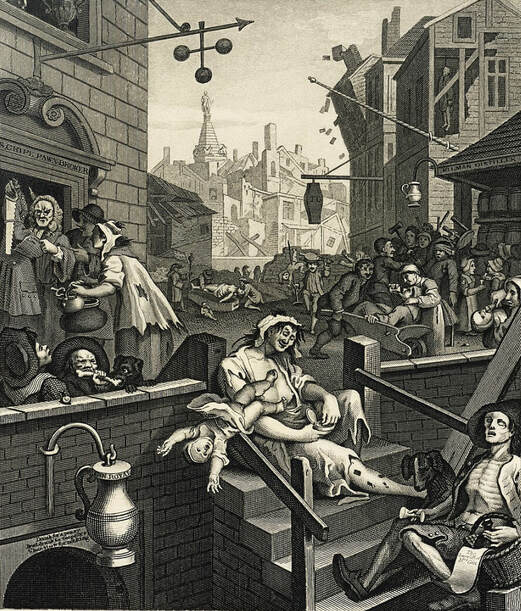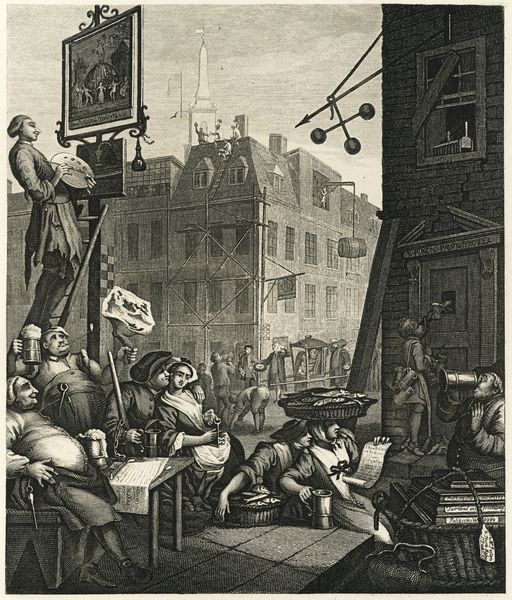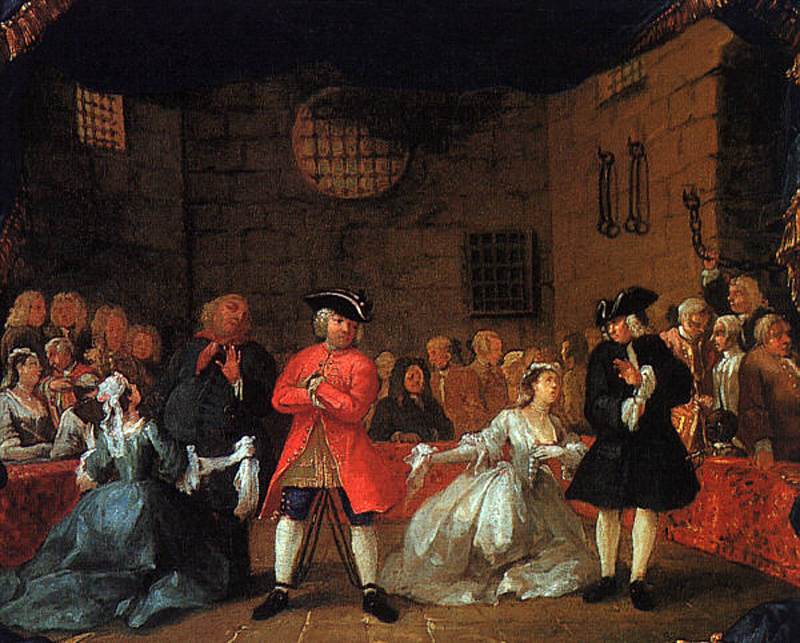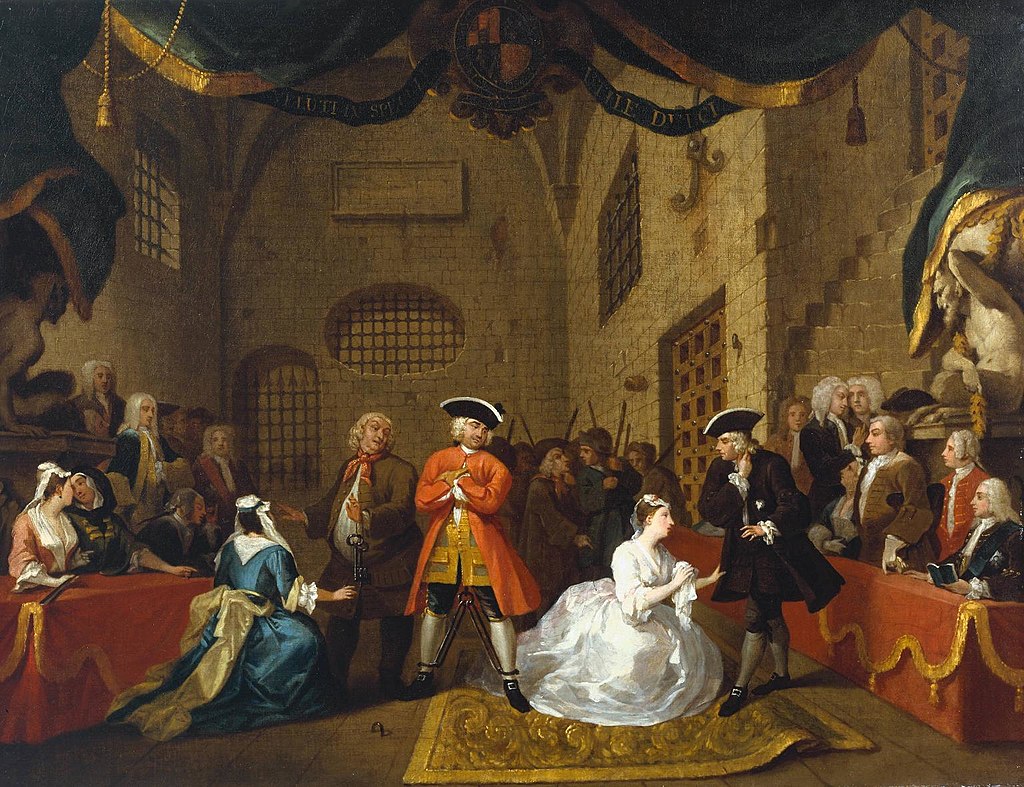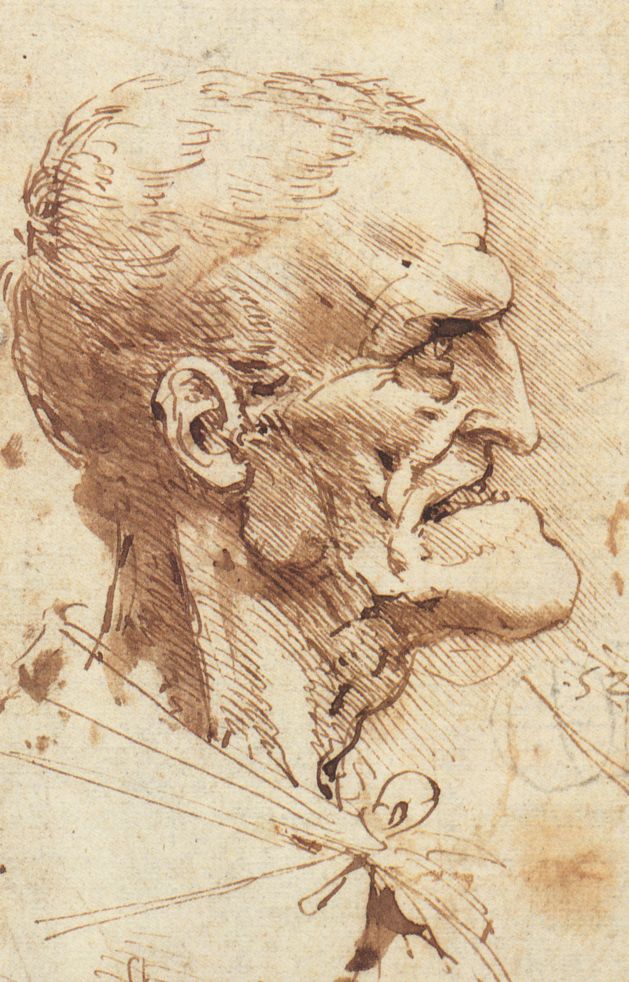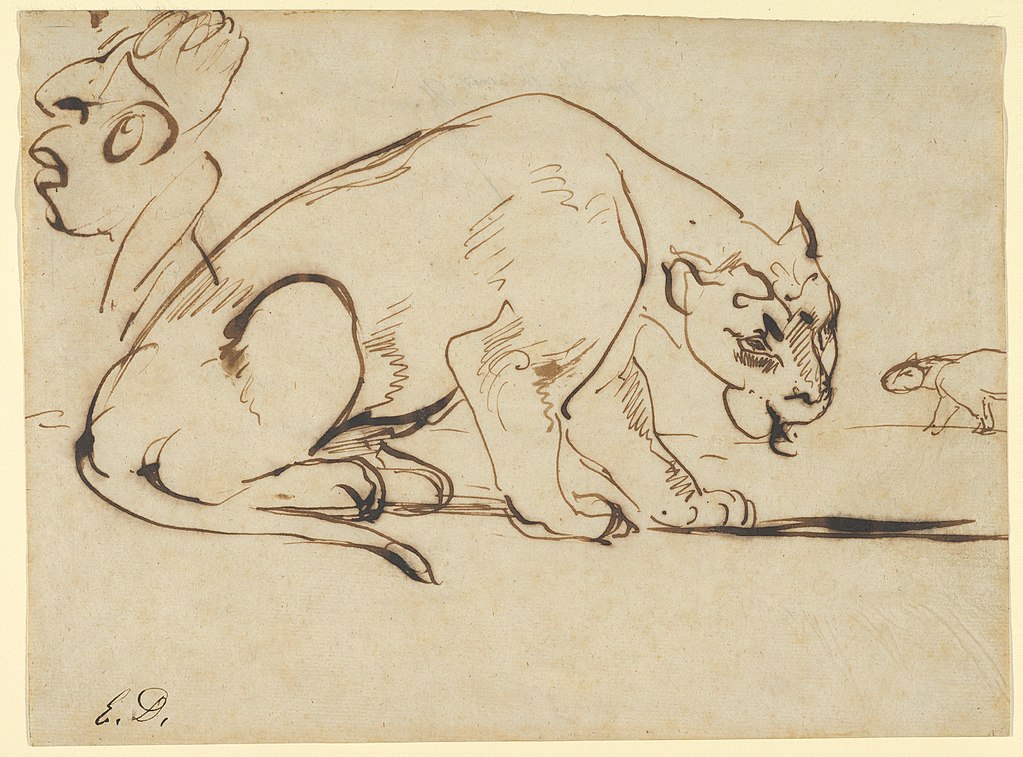|
Where? In the Museum of Modern Art, but currently not on display.
When? 1892 What do you see? A nude girl from Tahiti sits on a blue and white blanket. She is sitting in a dignified position with her back very straight, like the old Egyptians depicted people in art. She has some white flowers in her hair and in her left hand she holds a flowering mango (seed) that she seems to offer to the viewer. This flowering mango symbolizes fertility and was the sacred fruit of the Areoi society. On the bottom right is a three-legged table (called an umete in Polynesian) with more mangos in different colors. The girl is sitting against a background of pink flowers. In the background is the beautiful landscape of Tahiti which shows some mountains, water, trees, and a piece of the sky. Gauguin kept this painting relatively simple and did, for example, not include any shadows. He created a very colorful painting where the colors are not all very realistic. Backstory: This painting is also known under the Polynesian title Te Aa No Areois as can be seen in the bottom left corner. The painting was bought in 1936 by William S. Paley, a trustee, and the later president of the Museum of Modern Art. It was the first Gauguin painting acquired by the MoMA. Gauguin signed and dated the painting on the left side of the table with fruit in the foreground. The composition of the painting is similar to another Gauguin painting entitled Her Name is Vaïraümati (or Vairaumati Tei Oa) which is in the Pushkin Museum in Moscow. This painting deals with a similar theme, which is the origin of the Areoi society.
Who are the Areoi? Also referred to as the Arioi, it is a secret religious society in French Polynesia which does not exist anymore. At its origin is a myth about the god Oro who has intercourse with the most beautiful woman on earth, Vaïraümati, which results in the creation of a new race. The society had a hierarchical structure with several classes or ranks. While everyone, both men and women, could theoretically enter into each class within the Areoi, the highest classes were in practice mainly accessible for people from the higher classes of society. The highest class was reserved for priests.
Access to the society depended on your beauty, religious knowledge, recitation skills, and dancing skills. Moving up through the ranks was confirmed by increasingly large tattoos. Members of the society had sexual freedom until they married and were not allowed to get children. Most of the French Polynesian islands had their Areoi order, and they all had a place of worship and several houses in which the members met and where members of the other islands could stay. Who is Gauguin? Eugène Henri Paul Gauguin (1848-1903) was a Post-Impressionist artist from Paris. He was a self-taught painter without any formal education. He spent a large time of his youth in Peru where he developed his taste for traveling and exotic countries. In 1891, he moved to Tahiti in French Polynesia where he stayed until 1893 when he temporarily moved back to France. In 1895, he returned to Tahiti where he spent most of his time until his death in 1903. Gauguin is widely known for the idyllic and colorful paintings he made in French Polynesia. His work has had a big influence on artists such as Henri Matisse and Pablo Picasso. Other well-known works of Gauguin from his first period in French Polynesia are Hail Mary in the Metropolitan Museum of Art and In the Vanilla Grove, Man and Horse in the Guggenheim Museum in New York.
Fun fact: The girl in this painting is the Tahitian mistress/wife of Gauguin. Her name is Tehura, and she is 13 years old at the time of this painting. Soon after this painting, she was pregnant. She is depicted as Vaïraümati, the wife of the god Oro, who gave birth to a son who formed the beginning of the Areoi.
Gauguin wanted to paint the origins of this secret society which he claimed to have learned from Tehura. However, it is now assumed that Gauguin learned about this society through a travel book by Jacques-Antoine Moerenhout. In fact, Tehura was not aware at first that she was depicted as the mother of the Areoi. Interested in a copy for yourself? Poster of canvas.
0 Comments
Where? Room 506 on Floor 5 of the MoMA
When? 1911 What do you see? A look into the studio of Henri Matisse filled with his recent artworks scattered about the room. Among them are paintings on the walls, a stack of frames in the corner, vases, and ceramic plates. These objects seem randomly placed in the red room. Each painting, sculpture, and object is rendered in relative detail while the furniture in the room is represented with thin, almost invisible, yellow lines. Hardly present are a table, a dresser, two stools, a chair, and a grandfather clock with missing hands. This clock serves as the painting’s central axis and may suggest a disruption of time. Likewise, space is disrupted in the studio. The flatness of the red canvas is contrasted with a distorted perspective with improperly converging orthogonals and furniture that is depicted at varying angles. The curves of the plants on the table and the figures of his paintings contrasts with the rigidity of the picture frames, chairs, and the window on the far left. In this way, balance and harmony are created in the placement and color of the curated menagerie of objects in the studio. Backstory: The Red Studio, also known as L'Atelier Rouge, is part of a long-standing tradition of depicting the artist in his studio. Courbet, Velázquez, and Vermeer have all created similar paintings that show them at work in their own artistic space. But Matisse removes himself from his studio and instead represents himself with the artworks that are scattered around the room. These are all actual artworks that Matisse created. Matisse thus, untraditionally, represents himself with his own artworks. Matisse strays from tradition again by painting with reserve lines (rather than painting the entire canvas red and working on top of that layer, he leaves certain areas of the canvas unpainted and these unpainted areas form some of the lines and forms in this work). This can be seen in little gaps in paint near outlines where the bare canvas is revealed. This can be attributed to Matisse’s study of Cézanne’s works which is a departure from the Renaissance style of creating layers of oil paint.
Who is Henri Matisse? Henri Émile Benoît Matisse was born on December 31, 1869 in Le Cateau, France. When he was 22, he moved to Paris to study art. Already influenced by the Impressionists, he grew into a more abstract painter as he traveled the Mediterranean finding inspiration in the light there.
When Matisse returned from the Mediterranean, his work was exhibited alongside works by Derain and De Vlaminck, artists that were central in the formation of the Fauvist movement. While the other Fauvists received great criticism, Matisse’s reputation quickly grew. Finding identity in his Fauvist style, his works became more wild and colorful. In 1910, Matisse travelled to Spain and Morocco to study Islamic art and architecture. There, he found inspiration in patterns and incorporated detailed designs into his artworks. But just seven years later, Matisse retired to Nice and turned to a much more naturalistic style. Despite this regression, Matisse eventually returned to his abstract style in the 1930s only this time with paper cut-outs which include his Blue Nudes. Towards the end of his life, Matisse worked on the stained glass designs for the Chapel of the Rosary in Vence in the south of France. He died on November 3, 1954. Fun fact: The artworks in The Red Studio are all based on actual works by Matisse. These include Nude with a White Scarf (upper left) in the Statens Museum for Kunst in Copenhagen, Female Nude (lower right), and Bathers with a Turtle (upper right) in the St. Louis Art Museum.
What do you see? This marble statue shows the Greek demigod Perseus holding the head of Medusa. Perseus is standing in a triumphant pose as he has just beheaded Medusa. He holds the head of Medusa in his left hand by grabbing the venomous snakes on her head. The face of Medusa expresses horror as it has just been cut off. However, you can also still see the beauty of her face.
Interestingly, Perseus is looking at her face, even though that should turn him into stone according to the myth (but the irony may be that this actually happened in this statue). Perseus is wearing the sandals of the Roman messenger god Mercury (Hermes in Greek) which allowed Perseus to fly. These sandals were made of gold by the god Vulcan (Hephaestus in Greek). Perseus also wears the cap of Hades, which could make him invisible. In his right hand, Perseus is holding a harpe sword, which is a sword with a sickle-like extension on one side of the blade. The sword was owned by Zeus, the father of Perseus. A robe hangs loosely over his arm. Notice that his left foot is standing in the front, while the heel of his right foot is lifted. In this way, Canova creates the sense that Perseus is moving forward.
Backstory: Antonio Canova made this statue twice. The first version is on display in the Vatican Museums and is also known as Perseus Triumphant. A replica by Canova is in the Metropolitan Museum of Art. The head of Medusa in this statue has been inspired by the Medusa Rondanini, a marble sculpture that is in the Glyptothek in Munich.
The rest of the statue has been heavily inspired by the Apollo Belvedere, a famous statue from antiquity, which is also in the Octagonal Court of the Vatican Museums. The first version of the statue of Perseus and Medusa was acquired by Pope Pius VII to replace the Apollo Belvedere which Napoleon Bonaparte had confiscated and shipped to the Louvre in Paris. When the Apollo Belvedere returned to Rome, they kept the statue of Canova as it was such a great piece of work. When the second version of this statue first arrived at the Metropolitan Museum of Art, the sword was missing. They took a cast from the version in the Vatican Museums and added a newly carved marble sword to the statue.
The story of Perseus and Medusa: In Greek mythology, Perseus is the son of Jupiter (Zeus in Greek), who was the king of the gods, and Danaë. Polydectes, the King of Seriphos, ordered Perseus to provide him with the head of Medusa as a wedding gift for him.
Medusa was one of three sisters (Stheno, Euryale, and Medusa) who were often referred to as Gorgons. Both Stheno and Euryale were immortal, but Medusa was not. According to the Roman poet Ovid, Medusa was a beautiful young woman. However, after Poseidon (the god of the sea) made love to her in Athena’s temple, Athena (the goddess of wisdom and war) changed her beautiful locks into living, venomous snakes (in other mythological stories the three sisters were already born with snakes on their heads). Medusa had a horrific facial expression that could turn people (or according to some, only men) who looked at her into stone. Perseus used a shiny shield that he got from Athena to avoid looking at Medusa directly and succeeded to cut off her head. When Perseus returned to King Polydectes, he showed him the head of Medusa, which still retained its power, which turned Polydectes into stone. This was the purpose of Perseus as he discovered that Polydectes had abused his mother. Perseus and Medusa in art? Perseus and Medusa have been a popular subject in art. Famous artists have used their story as the inspiration for their artwork. Leonardo da Vinci created two version of the head of Medusa, but neither of them has survived. Caravaggio has painted the head of Medusa on a shield which is in the Uffizi Museum. Rubens also created two versions of the Head of Medusa, of which one is in the Kunsthistorisches Museum in Vienna. Various sculptures of Perseus and Medusa have also been made, such as one by Benvenuto Cellini.
What is neoclassicism? Around 1760, neoclassicism started in Rome in opposition to the then-popular Baroque and Rococo styles. The neoclassic style quickly spread through Europe and become especially popular in France, with artists such as Jacques-Louis David and Jean-Auguste-Dominique Ingres.
Neoclassic art is inspired by the old Roman and Greek art and focuses on simplicity and symmetry. The paintings, sculptures, and architecture in this style did not show much emotion, were more ordered and down-to-earth compared to the Baroque style and were less playful compared to the Rococo style. Fun fact: When making a statue of marble, the artist needs to be aware of the center of gravity. In this sculpture, the stretched arm of Perseus and the head of Medusa naturally shift the center of gravity. Canova included two tricks to keep the sculpture stable and decrease the chances that it gets severely damaged by movement or that the head would simply break off.
Where: 141 Wooster Street, New York City
When: 1977 What do you experience? The Earth Room contains 280 thousand pounds of soil (dirt) filling up the 3600 square feet second floor apartment in the heart of New York City. It measures up to about 22 inches in height and is contained partly by the white walls and partly by a glass barrier only inches taller than the level of dirt. Unlike most other types of sculptures, which can be experienced at distance (a photograph can give us an idea of the work and artist’s creativity), the Earth Room should be experienced in person. Besides the visual or even tactile levels of perception, the Room evokes an olfactory experience. The visitor can smell the art. The scent of fresh soil can be felt long before you get to see the actual work, while walking up the stairs leading to the second floor of the building where it is located. The overall impression is similar to that of experiencing the ocean for the first time; one can smell the water long before it becomes available in any other way. In the Earth Room, the scent of the fresh soil intensifies dramatically as we stand in front of the exposition. How does it remain fresh? Bill Dilworth, the curator of the Earth Room, explains the life that has been happening inside the dirt. Originally from Detroit, Dilworth has lived in New York for about 40 years and has been taking care of the New York Earth Room for nearly 30 of those years. While life in the Earth Room dirt is limited by the enclosed space, and it does not have the same kind of substances present in a natural environment, scientists have claimed that some microorganisms can survive in such conditions for up to 200 years. Tests of dirt samples revealed all sorts of life present. One of Dilworth’s routine tasks is to water the dirt, partly to limit the dusting inside the apartment. One of the side effects of that task is the continued sustainability of life present in the sculpture.
Land Art: The Earth Room represents Land Art, a creative phenomenon of the 60s and 70s. Land Art focuses on experiments with free-form, conceptual Post-Minimalism and concern with environment. The work is intentionally simple. Yet, its simplicity is what is so puzzling about it and what provokes the desired outcome: a reflection, a thought, and a pause. There is no specific indication as to where the soil in the Room comes from; it is unimportant as it has carried humanity with equal effort throughout the ages, wherever there was soil.
How significant is it for us to realize and how do we perceive the land? Are we making the best use of the earth? Is that even the proper way to think about it? Artists have been making landscapes the subjects of their works for a long time. Why not consider the material—dirt—to have an independent aesthetic quality or even to be one? Those are some of the notions Land Art evokes. Others include the concern about the human impact on that quality. In that sense, art seems to be ahead of theory, as evidenced by the recent outpour of research on the climate change. Working with non-traditional materials, the value of the process itself, and challenging the commercialization of art were at the core of Post-Minimalist movement out of which Land Art grew. The movement challenged the status of commercial merchandise to which art was reduced. Contrast with city life: A unique feature of the Earth Room is its contrast with city life. The visitor experiences silence and serenity. In the heart of “the city that never sleeps,” the Earth Room’s atmosphere is an oasis of peace and quiet. The earth absorbs while offering a nearly spiritual experience. The feature of solitude is consistent with De Maria’s claim that “Isolation is the essence of land art.” De Maria's other work, The Lightning Field (1977), is in New Mexico’s desolate area near Quemado. Another land artist, Robert Smithson, located his earth sculpture, the Spiral Jetty (1970), in Rozel Point, Utah, on the northeastern shore of the Great Salt Lake, making it inaccessible altogether for an in-person experience. Other Earth Rooms: Originally, there were three Earth Rooms, two in Germany and one in New York, which was the last one installed. They were all initially shown through gallery exhibitions. The New York Earth Room was intended to last three months, but it is now the only Earth Room left. It was taken up by Dia Art Foundation. The foundation has commissioned and/or maintained number of projects, with the goal of helping artists realize their visions, especially those visions which often reach beyond the scope of traditional gallery exhibitions. Who is De Maria? Walter Joseph De Maria was born in 1935 in Albany, CA and died in 2013 in Los Angeles, CA. In 1960, he moved to New York where he stayed the remainder of his career. His artistic interests included Conceptual, Land, and Minimal Art. Among his famous works are the New York Earth Room, The Lighting Field, The Broken Kilometer, and The Vertical Earth Kilometer. Fun fact: Initially, about 3500 people annually visited the Earth Room. Nowadays that number is about 16,000. With the growing awareness of human impact on the environment, it seems likely that the number of visitors will continue to rise. The New York Earth Room remains one of the most unique forms of Land Art. 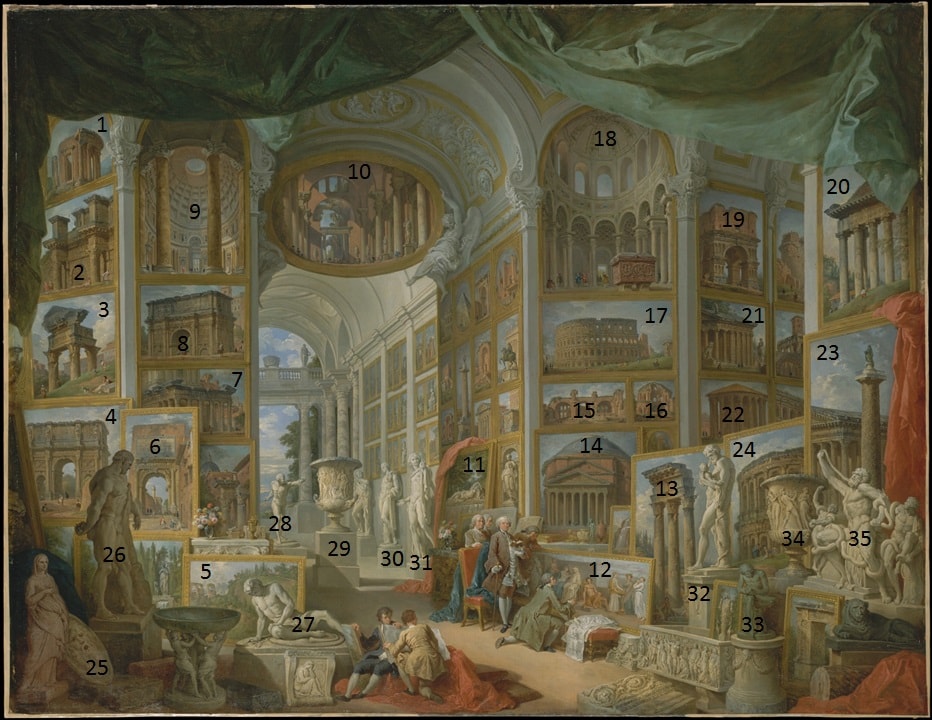 Annotated Ancient Rome Annotated Ancient Rome
Where? Room 629 of the Metropolitan Museum of Art
When? 1757 Commissioned by? Count de Stainville What do you see? On top is a green curtain that is pulled aside to show many paintings and sculptures of ancient Roman monuments. Panini and his patron Count de Stainville appear in the painting. Panini is standing directly behind the chair in the middle, while Count de Stainville is standing in front of him with a book in his hand. In the figure below the paintings are numbered to make it easy to understand what they represent.
Backstory: The painting was created together with a painting of Modern Rome, which is in the same room of the Metropolitan Museum of Art. The idea was that the monuments in this painting represent all the works that a young gentleman of a good family should see on his tour of Rome. This kind of tours was popular among the rich to educate young men about the cultural world.
There are three versions of the Ancient Rome painting and they all look slightly different. Besides the version in the Metropolitan Museum of Art, the Staatsgalerie in Stuttgart has on version, and the Louvre has another version. Why Rome? Rome was the capital of the Roman Empire. It is considered to be the birthplace of the Western civilization. It contains a large number of ruins, monuments, buildings, museums, etc., of significant historical importance. Since the beginning of the Renaissance, it has attracted many well-known artists and contributed to their development. Who is Panini? Giovanni Paolo Panini (1691-1765) was an architect, painter, and professor. He is known as a vedutisti, which is a painter of a veduta (Italian for ‘view’). A veduta is a highly detailed painting of a certain view, such as a city or landscape. While born in Piacenza, he spent most of his life in Rome, which has been the dominant theme in his paintings. Fun fact: Panini painted multiple versions of this painting within three years. The painting is part of a set of three other paintings, a painting of Modern Rome, a painting of Saint Peter’s Square, and a painting of the interior of Saint Peter’s. Because of the popularity of these paintings, he created this set of four paintings twice (remember that there were no photographs possible in his time, so this was probably the best you could get as a picture of Rome). He also created a third and fourth version of Ancient Rome and Modern Rome. Interested in a copy for yourself? Poster or canvas.
Where? Room 629 of the Metropolitan Museum of Art and Gallery 246 of the Museum of Fine Arts
When? 1757 Commissioned by? Count de Stainville What do you see? A large number of paintings of buildings, fountains, and monuments in Rome around 1757. The commissioner of this painting, Count de Stainville, who was the French ambassador to the Vatican in Rome between 1753 and 1757, is sitting in an armchair in the foreground. In the painting below the paintings and sculptures are numbered to make it easy to understand what they represent.
Backstory: Panini created a total of three versions of this painting. He created two similar versions for Count the Stainville. The original version is at the Museum of Fine Arts in Boston, and a copy of that version is at the Metropolitan Museum of Art. Two years later, he created a somewhat different version of this painting for Claude-François de Montboissier de Canillac de Beaufort. This version is now in the Louvre in Paris.
The Modern Rome painting in the Metropolitan Museum of Art hangs next to another work of Panini, Ancient Rome, which shows monuments and art from ancient Rome.
What is a veduta? Panini is known for painting views of Rome. These views are called veduta (plural vedute), which is a type of painting that accurately provides a view of a city or another vista. This style initiated in Belgium and The Netherlands in the 17th century and became more popular in 18th-century Italy.
There are two main types of vedute. First, the vedute prese da i luoghi, which are exact representations of a city view or other vista. Second, vedute ideate, which are scenes that also contain some imaginary elements such as buildings or monuments from the past. The current painting by Panini is a good example of the first type of veduta, while his Ancient Rome is a good example of the latter type. As photography did not exist yet, vedute were a great way for rich travelers to bring home their memories. The magnificent vedute by Panini were in high demand in the 18th century, and it is not surprising that painters sometimes created multiple versions of the same veduta painting. Who is Panini? Giovanni Paolo Panini was born in 1691 in Piacenza, Italy, and died in Rome in 1765. He was both an architect and painter and was considered to be the most influential painter in Rome during the 18th century. Early in his career, he mainly painted frescos for the rich people in Rome. From around 1729, he started to focus on painting various views of Rome for which he is best known today. Another example of a veduta painting by Panini is the Interior of the Pantheon of which one version is in the National Gallery of Art, and another version is in the Cleveland Museum of Art. Panini also painted some religious works, but these works have never reached the same amount of fame as his vedute.
Fun fact: At the end of the 16th century, rich people in Europe send their kids on tour through Europe as part of their education. These trips are referred to as Grand Tours. On these trips, kids of about 21 years old typically visited cities such as Paris, Florence, Rome, and Venice. A knowledgeable family member or a professional tutor accompanied them on their tour. For example, the great economist and one of the founders of capitalism, Adam Smith, worked for quite some years as a tutor.
Before the existence of photography, these tours were popular among the rich people in England, Germany, Scandinavia, and the United States. Veduta paintings, such as the ones by Panini, became popular among these people to preserve their memories.
Where? Room 621 of the Metropolitan Museum of Art
When? 1595 Commissioned by? Cardinal Francesco Maria del Monte, the patron of Caravaggio. What do you see? Four boys dressed in semi-classical costumes. Three of the boys are playing music. The central figure is holding a lute and is thought to be Mario Minniti, a friend of Caravaggio. His eyes are moist and full of tears. The second boy from the right is a self-portrait of Caravaggio, who is playing a cornetto (a horn-like wind instrument of about two feet long; you can see the end of the instrument on the top right of the painting). The boy on the right is studying the musical score. The boy on the left is representing Cupid and is reaching for some grapes. In the foreground are two open books with musical scores as well as an unused violin. These elements seem to invite the viewer to participate with the musicians. Backstory: This painting is also known as the Concert of Youths. The boys are practicing madrigals, which are a secular (as opposed to religious) vocal music composition from the Renaissance. The song they are practicing deals with the sorrows of love. Symbolism: The boy on the left represents Cupid. The gathering of grapes by Cupid represents love. The grapes are also representing the fact that music should make the spirits light. Cupid has wings and arrows. The arrows are the main symbol of Cupid (together with the bow). Cupid typically has two kinds of arrows. Arrows with a sharp golden tip, which can fill someone with uncontrollable desire, and arrows with a blunt tip of lead, which can fill someone with aversion and the desire to flee. Cupid seems to have the latter type of arrows here. Why musicians? Musical scenes became popular during Caravaggio’s time, mainly due to the Church that started supporting various forms of music. Hence, the inspiration for this theme came from Cardinal Del Monte, who was heavily involved with the Church. Del Monte also organized various concerts at his palace. However, interestingly, the music that is played in this painting is nonreligious. Who is Francesco Maria del Monte? At age 24, Caravaggio entered the household of the Italian cardinal, diplomat, and art connoisseur, Francesco Maria del Monte (1549-1627). The cardinal paid Caravaggio for his work. Del Monte was an important art collector during his time in Rome and left a collection of about 600 paintings at his death. He commissioned more paintings from Caravaggio, including Bacchus (in the Uffizi Museum) and The Fortune Teller (in the Louvre). In addition to his love for paintings, Del Monte was also a big fan of music which explains the musical theme in this painting. In his large house, the Palazzo Madama, the cardinal hosted both artists like Caravaggio and various musicians. He paid for their musical education and gave them a place to stay.
Who is Caravaggio? Michelangelo Merisi da Caravaggio (1571-1610) was trained by Simone Peterzano, who was in turn trained by Titian. He used a realistic painting style, paying both attention to the physical and emotional state of the subjects he painted. He combined this with a brilliant contrast between light and shadow in his paintings.
Caravaggio lived a tumultuous life and was accused of murder, assault, many fights, and has served in prison. However, his sheer brilliance as an artist has given him a place in the history books. His painting style has had a big influence on the development of Baroque painting (which includes drama and an intense contrast between light and dark). Some well-known paintings by Caravaggio are his Medusa in the Uffizi Museum and Sleeping Cupid in the Palazzo Pitti.
Fun fact: This painting has been missing for centuries. While many artists in the 17th century mentioned this masterpiece, it only turned up in 1952, when the Metropolitan Museum of Art announced that the painting had been found and they included it in their museum. Less than two decades before, the painting had been sold for 100 pounds in England, where both the buyer and seller did not recognize that this was the missing painting of Caravaggio (mainly due to the bad state in which the painting was).
Interested in a copy for yourself? Poster or canvas.  The wife of Socrates The wife of Socrates
Where? Room 621 of the Metropolitan Museum of Art
When? 1787 Commissioned by? The Trudaine de Montigny brothers What do you see? Socrates is sitting on his deathbed in his cell and is reaching for the glass of hemlock to take his own life. He is convicted to death by a jury in Athens for not believing in the Greek gods and for sharing this view with the young people in Athens. You can see the opened shackles laying on the floor. His disciples are gathered around him and cannot believe what is going to happen. The executioner from the state is holding the glass for Socrates while looking away and covering his eyes. Even in the moment just before his death, the illuminated Socrates is teaching to the people around him with his hand up in the air. Plato is sitting at the end of the bed with his back towards Socrates and his eyes closed. He seems in his thoughts, but his ear is prominently depicted to indicate that he is listening to Socrates. Plato has documented several dialogues of Socrates as Socrates himself did not leave any written documents. You can see the scroll and the pot with ink at Plato’s feet to indicate that he will document the final speech of Socrates. Sitting to the right of Socrates is Crito, a good friend of Socrates, who has his arm on his leg. Crito is sitting on a bench with an inscription of the symbol of the Athenian state. The wife of Socrates, Xanthippe, is in the left background in a red robe. She waves at us while walking away. Backstory: This painting is largely based on a dialogue of Plato, entitled Phaedo, in which he describes the death of Socrates. In this dialogue, Socrates discusses the life after death on the day before his execution. Socrates discusses various arguments on why the soul is immortal and that there is an afterlife for the soul. For his crimes, Socrates could choose between drinking the glass of the poisonous hemlock or being exiled. Given his ideas that his soul would go to an afterlife and staying true to his beliefs, he chose to drink the glass of hemlock. This painting can be interpreted in a political context. The Trudaine de Montigny brothers (who commissioned this work) were leaders of a movement that called for more open public discussion of political matters and a free market system. The motive behind this painting was to depict Socrates as an example of someone who was willing to die for his ideals. In 1787 reforms to the French political system were abandoned and there were many political prisoners. What is discussed in Phaedo? Phaedo is the fourth and final dialogue of Plato about the death of Socrates. In Phaedo, the story of Socrates is told about why he thinks that the soul is immortal and that there is life for the soul after a person dies. Phaedo also describes the death of Socrates. In short, the four arguments of Socrates are:
Who is Socrates? Socrates is one of the founders of Western philosophy. He was married to Xanthippe and got three sons. Socrates did not write any of his ideas on paper, but some contemporaries, such as Plato, have documented the ideas of Socrates such that his ideas have been saved for future generations. One of his most important contributions to the world is the so-called Socratic method. To solve a problem, Socrates would ask you a question. Based on your answer he would ask you another question, followed by another question, etc. He forced people to critically think about their answers by engaging them in the topic. If some of those answers led to contradicting answers, a certain hypothesis about the problem could be eliminated, and a better one could be formulated. It is basically a test of logic and will help a group of people to determine their views on a certain problem. The Socratic method has led to the currently-used scientific method that academicians use in which one starts with a hypothesis which can be rejected or accepted after research. Who is Jacques-Louis David? Jacques-Louis David (1748-1825) was born in Paris. He was a Neoclassical painter and together with Antonio Canova he is one of the main representatives of this art style. In his twenties and thirties, he spent quite some years in Rome where he got inspired by the Renaissance paintings and especially by the work of Raphael. David supported the French Revolution and Napoleon, and one of his famous paintings is The Coronation of Napoleon which is in the Louvre. After the fall of Napoleon, he moved to Brussels where he stayed until his death. He loved to make historical paintings while staying true to his Neoclassical style. In this painting, you can, for example, see how the body of Socrates resembles an ancient Greek sculpture. One of his most famous students is Eugene Delacroix.
Fun fact: There are several aspects of this painting that Jacques-Louis David changed compared to the historical accounts of the death of Socrates.
Where? Room 1730 of the Main Floor of Tate Britain. Several other museums like the British Museum, Metropolitan Museum of Art, and National Gallery of Art also own this work but do not have it on permanent display.
When? 1751 What do you see? Several groups of well-fed people engage in a variety of activities while drinking mugs of beer. It is the birthday of King George II, and that asks for a celebration. On the left, two corpulent men hold big mugs of beer and one of them holds a huge leg of beef in his left hand. In front of them sits a man holding a beer while sharing a romantic moment with a woman. To the right of them, a couple of women with overflowing baskets of fish pause while enjoying a beer. To their right, a young boy with mugs hanging on a rope slung over his back goes around selling mugs of beer. He stops at the pawnbroker to hand him a beer through the peek hole. The pawn shop is in some state of disrepair as people do not need to pawn off their belonging in this prosperous world where people drink beer. The other buildings are well-maintained, and the church steeple on the top is a sign that people behave morally in this world full of beer. On the bottom right, a portly man enjoys his beer next to a pile of books in a basket. On the left, a painter in ragged clothes blissfully paints a cheery picture of men and women dancing around a mountain of barley. On top of the roofs, construction workers take a break drinking to celebrate while another barrel of beer is being lifted up. Finally, in the center, a wealthy woman in a sedan chair waits as her chairmen have temporarily put her chair down to drink a beer. Laborers around them drink their beer while continuing their work in a timely manner. Backstory: Beer Street takes place during a major movement in 18th-century England: The Age of Enlightenment. This was a philosophical and intellectual movement where people began to ponder major scientific and philosophical thoughts that were captured in paintings such as The Anatomy Lesson of Dr. Nicolaes Tulp by Rembrandt. These ideas were published, and many people learned from them and developed them further. Another idea behind the Age of Enlightenment is that people were trying to apply these new ideas to help other people. Before the Gin Craze, French brandy was popular and fashionable, however, during the Second Hundred Years’ War between France and England, French products were considered unpatriotic and soon lost their following. This led to the Gin Craze where gin and other cheap spirits quickly became popular, and overconsumption of these drinks caused many problems among the lower-class people. William Hogarth’s print was, in essence, a piece of propaganda in favor of the British beer market. Similar to the popularity of Coca-Cola in the United States during modern times, Hogarth makes the argument that beer was not only a remedy to the unregulated gin trade but also a drink that is truly British and helps the country.
Gin Lane: At the time Hogarth created Beer Street, he also created a companion piece called Gin Lane. Most museums that own Beer Street, also have a print from Gin Lane as they were created together. Museums owning Gin Lane include Tate Britain, the British Museum and the National Gallery of Art. However, most museums do not have the prints on permanent display as they are light sensitive. The original copperplates for both works are owned by the Metropolitan Museum of Art.
Gin Lane shows the perilous effects that excessive gin consumption can have on your life. It shows the opposite side of Beer Street where drinking gin leads to chaos, negligence, street brawls, and poverty. The only ones benefiting from the gin craze are the distillery, the pawn shop, and the undertaker.
Who is Hogarth? William Hogarth was born in 1697 in London where he would die 66 years later. Hogarth carefully examined life in 18th-century London and detailed it in etchings and painted satires. He included many symbolic features in his works such that his pieces are not only entertaining but also contain several moral messages.
Hogarth created art both for the upper and lower class. He painted works for his richer clients but also created etchings and engravings of his works that could be mass-produced and sold at a lower price to a larger audience. Among his works is a series of satirical works about the British upper class. The first painting of that series is Marriage A-la-Mode: 1, The Marriage Settlement in the National Gallery in London.
Where? Room 1730 of the Main Floor of Tate Britain. Several other museums like the British Museum, Metropolitan Museum of Art, and National Gallery of Art also own this work but do not have it on permanent display.
When? 1751 What do you see? People in various states of physical and mental decline amid a chaotic urban setting. In the center sits a woman with ragged clothes. Her shirt is open exposing her breasts, and she has sores on her legs. She neglects her baby who falls out of her arms and does not even notice what is happening. Just down the steps from her lies a malnourished soldier who looks like a skeleton. He has his head tilted back and holds on to an empty glass of gin. A dog with a saddened expression looks over him. The soldier has a basket tucked under the crook of his arm with a bottle and note that reads “The Downfall of Gin.” To the left of the central woman, two men fight with a dog over a bone signifying how far they have fallen because of their gin addiction. Standing above them, a couple of men try to pawn off possessions to buy more gin. On the right side, more people lose themselves to the cheap spirits. People are feeding gin to each other, including children, and even a baby. In front of the distillery on the right middle, a fight breaks out and people hit each other with chairs and hammers. There is a strong contrast between the different buildings in this town. Most buildings in the background are in poor condition, except the distillery, the pawn shop, and the undertaker’s building. Backstory: Gin Lane is an etching and engraving printed on paper. Hogarth chose this technique to be able to produce multiple prints of his work that he could sell for low prices to lower-class people. Gin Lane showcases the vicious cycle of excessive drinking, pawning off your possessions to drink more, prostitution, and finally death. Gin drinking was considered a large problem in England during the time that Hogarth created this work. It was cheap and accessible to the working class, and many people got addicted to gin with all the bad consequences that result from that. Gin Craze: In the beginning of the 18th century, gin was not regulated in England, and distillers did not care much about the drink’s quality. They mixed in harmful chemicals and did anything to increase their margins. The drink became very popular among the lower class in England, and especially in London. Many people consumed large quantities of gin, which made them even poorer and led to health problems. The problems with gin led the government to take several measures between 1729 and 1751 to make gin more expensive and reduce its popularity. These measures only had a partial effect, and it was not until the 1750s that the gin consumption decreased mainly due to a series of poor grain harvests. Beer Street: At the time Hogarth created Gin Lane, he also created a companion piece called Beer Street. Prints of this work are part of multiple collections, including the British Museum and the National Gallery of Art. The original copperplates for both works are owned by the Metropolitan Museum of Art. Beer Street presents an alternative to the ails of gin drinking. It shows the opposite of the street where we see that beer drinking leads to prosperity. It shows a town that is flourishing with healthy individuals engaging in fun activities. For example, the pawnbroker that thrived in the chaos in Gin Lane is in disrepair as no one wants to pawn items to support their habit.
Who is Hogarth? William Hogarth was born in 1697 in London where he would die 66 years later. He enjoyed creating art which explains the social ills of 18th-century England through a combination of wit and symbols that would be easy to understand for his 18th-century audience. He created art both for the upper and lower class.
Hogarth painted works for his richer clients but also created etchings and engravings of his works that could be mass-produced and sold at a lower price to a larger audience. An example of a work for the upper class is A Scene from 'The Beggar's Opera' in the National Gallery of Art. Another version of this painting is in the same room as Gin Lane in Tate Britain.
Fun Fact: In addition to being a political satirist, William Hogarth is known for his caricatures of people. Look, for example, at the man hanging from the rafters in the top right of Gin Lane or the man in the center walking down the street with a baby on a stake.
Other artists like Leonardo da Vinci and Eugene Delacroix also liked to create caricatures of people. One of Da Vinci’s many caricatures is a drawing of a Grotesque Profile. An example of a caricature by Delacroix is A Lioness and a Caricature of Ingres in the Metropolitan Museum of Art. |
Categories
All
|
- Home
- Blog
-
Museums
- Alte Pinakothek
- Art Institute of Chicago
- Baltimore Museum of Art
- Barber Institute of Fine Arts
- Bargello
- Barnes Foundation
- British Museum
- Church of Sant’Anastasia
- Cleveland Museum of Art
- Courtauld Institute of Art
- Detroit Institute of Arts
- Frans Hals Museum
- Galleria Borghese
- Gallerie dell'Accademia
- Getty Museum
- Guggenheim
- Hermitage Museum
- Kunsthistorisches Museum
- Kunstmuseum Basel
- Legion of Honor Museum
- Louvre
- Mauritshuis
- Metropolitan Museum of Art
- Musee d’Orsay
- Museum of Fine Arts in Boston
- Museum of Modern Art
- National Gallery in London
- National Gallery of Art
- National Museum in Poznań
- Norton Simon Museum
- Ny Carlsberg Glyptotek
- Palace of Versailles
- Palazzo Pitti
- Palazzo Vecchio
- Petit Palais
- Philadelphia Museum of Art
- Prado
- Pushkin Museum
- Ravenna Art Museum
- Rijksmuseum
- San Diego Museum of Art
- Santa Maria delle Grazie
- St. Peter's Basilica
- Städel Museum
- Statens Museum for Kunst
- Tate Britain
- Tate Modern
- Timken Museum of Art
- Uffizi
- Vatican Museums
- Wallace Collection
-
Artists
- Altdorfer
- Anguissola
- Berlin Painter
- Bosch
- Botticelli
- Boucher
- Bronzino
- Bruegel the Elder
- Brunelleschi
- Cabanel
- Caillebotte
- Canova
- Caravaggio
- Carpeaux
- Cezanne
- Cimabue
- David
- Degas
- Delacroix
- De Maria
- Donatello
- El Greco
- Fontana
- Fra Angelico
- Fragonard
- Gauguin
- Gentileschi
- Gericault
- Gonzalez-Torres
- Goya
- Hals
- Hogarth
- Hokusai
- Ingres
- Leonardo da Vinci
- Lippi, Filippo
- Longhi, Barbara
- Lorrain
- Makovsky
- Manet
- Massys
- Matisse
- Merian
- Michelangelo
- Mochi
- Modigliani
- Monet
- Panini
- Parmigianino
- Perugino
- Picasso
- Pisanello
- Raphael
- Rembrandt
- Renoir
- Reynolds
- Rivera
- Rodin
- Rubens
- Scultori
- Seurat
- Steen
- Tintoretto
- Titian
- Toulouse-Lautrec
- Turner
- Uccello
- Van der Weyden
- Van Dyck
- Van Eyck
- Van Gogh
- Van Hemessen
- Vasari
- Velazquez
- Vermeer
- Veronese
- Vigée Le Brun
-
Locations
- Books
- About Us

